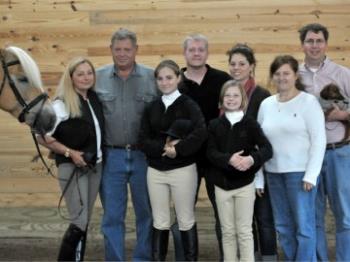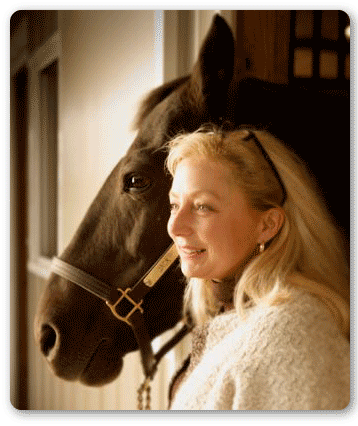Do Your Homework

The 21-acre farm was enclosed by all kinds of fencing; including board, posts and rail, woven wire and one stretch of fencing appeared to be made from a rubber conveyor belt. In all cases, the fencing was in ill-repair and needed replacing.
Like many horse owners, the Disbrow's wanted to put up the best fence their money could buy. While they wanted to make the best economic decision, they considered their animals' safety first.
Debbie Disbrow was an experienced equestrian, and understood the importance of having the proper fence enclosure for horses. The couple made a major investment in purchasing and installing their new plastic flexible fence. When the project was completed the fence and enclosed property looked beautiful. Sadly, two years after being installed, the fence began showing signs of wear. The fence began ripping, cracking and flaking, resulting in exposed wires. The white fence was discolored yellow and there was evidence of mildew in the coating. The Disbrow's thought they had purchased a fence which was safe and maintenance free; instead they had a fence in dire need of repair.
Today, flexible fencing is much more reliable and durable.
When the Disbrow's bought their fence, flexible fencing was a relatively brand new product on the equine market. Most of the fences in their area were made of wood, high-tensile wire or woven wire. Understandably, the Disbrow's were excited about the new fencing. "We thought we had done our homework before purchasing the fence," said Debbie. "Maybe we didn't know what questions to ask at the time, or maybe we were just smitten by the new product. Looking back, it's certain we didn't understand what materials were used to make the fence and how long it would last."
After discovering the warranty didn't cover the deteriorating fence, the Disbrow's began thoroughly researching fencing options.
The couple discovered what each fence product was made of and how it was manufactured. They replaced the three-year old fence with another new product and after two decades the fence is still standing and in good shape. Shortly after solving their fencing dilemma, the Disbrow's decided to help other horse owners with similar fencing questions. They took what they learned from their own personal experience and other experienced horse owners, and started a fencing distribution company.
Today, RAMM Horse Fencing and Stalls of Ohio distributes quality fencing products throughout North America and into Europe, and throughout the world.
The company is dedicated to helping horse owners find the right fencing option to meet their specific needs. "It's so very important to first consider your particular needs when buying a fence," said Debbie. "While we recommend you talk to experienced horse people about what did and didn't work for them, you need to also consider your special circumstances. What worked for one horse owner might not apply to you. You have to do your homework."
All things considered
As previously mentioned, horse owners need to consider a number of factors when buying fencing.
One of the first things horse owners need to consider is setting.
Topography, climate and soil composition can render some fence types incompatible with the desired application. Many fence types, like woven wire fences, don't work well following rises and dips in the land, and so it's important to consider the lay of your property. Each soil type - clay, sandy loam, and rock - present its own challenge when installing fence posts. The type of soil often determines the depth corner posts are set at, the amount of cement and bracing required, the type of material used and ultimately the overall cost.
Like soil, climate can be a determining factor of what type of fencing material works best.
Not all materials, natural and manufactured, hold up well in extreme temperatures. For example, strung wire may expand and contract, and many plastics become brittle or warp under extreme changes in temperature. According to Debbie, temperatures also dictate how deep posts should be set at, typically an additional half–foot in colder temperatures. "The posts are the backbone of any fence," explained Debbie. "A fence can't function properly without proper posting and bracing. Because of this, all factors must be considered including soil and climate."
Another thing to think about is the size and type of horse the owner is planning to fence in.
While the standard fence height is 4.5-feet, Debbie recommends taller horses be kept in fences reaching 5-feet. The fence should be tall enough so the top rail is at the wither height of the tallest horse kept. Nursery paddocks enclosing foals require special fencing consideration. It's not uncommon for a foal to slip through or get caught up in a fence. Fences enclosing foals need to be made of a safe material and assure a foal can't roll underneath or step through openings. Not all fencing types are appropriate for nursery paddocks. "Spacing between fence rails is crucial when fencing a nursery paddock," noted Debbie. "The spacing between rails for adult horses is normally between 9-to-11-inches, but when fencing foals or miniature horses the spacing should be no greater than 6- to 8-inches."
The height of the fence and rail spacing will determine the number of rails required.
Of course, the more rails used the higher the cost for fencing materials and installation. A good way to reduce these costs is to install 1-inch flexible rail, electric tape or other safe, temporary fencing between rails.
A smart horse owner takes into account installation when planning the purchase of a fence.
Often, installation can cost as much as the fence itself. Before deciding to install your new fence in hopes of saving money, it's important to consider the fence type. While many fences are easy to install, others such as strung wire require experience. A poorly installed fence will cost more money in the long run. "You need to get the fence which best fits your specific needs and budget," concluded Debbie. "However, a fence which appears to make good economic sense, isn't necessary the cheapest fence. The fence which cost the horse owner the least amount of money, over an extended period of time, is typically the best choice."
 Debbie has over 45 years experience with horses and equine-related businesses. She has owned, trained, boarded horses and run stables at various times in her career. She is a certified fence installer, has given balanced riding lessons, and has shown horses in Western, Western Pleasure, Trail, English, Hunter/Jumper, Fox Hunting, Hunter Trials, Dressage and driving classes. Debbie has been involved in foaling, and just about every aspect of horse ownership possible, and she welcomes your questions and comments. If you are interested in using any articles by Debbie, please send her an email.
Debbie has over 45 years experience with horses and equine-related businesses. She has owned, trained, boarded horses and run stables at various times in her career. She is a certified fence installer, has given balanced riding lessons, and has shown horses in Western, Western Pleasure, Trail, English, Hunter/Jumper, Fox Hunting, Hunter Trials, Dressage and driving classes. Debbie has been involved in foaling, and just about every aspect of horse ownership possible, and she welcomes your questions and comments. If you are interested in using any articles by Debbie, please send her an email.
RAMM Fence Systems, Inc. makes every effort to provide reliable and useful information on horse health, care and products. The statements made on this website are based on years of experience with horses, however, they are based on generalized situations and should not replace diagnosis or treatment by a veterinarian or consultation by a professional. RAMM Fence Systems, Inc. does not assume any legal responsibility. Readers should always consult qualified health care providers for specific diagnosis and treatment.
